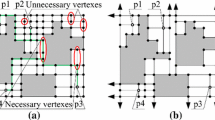Abstract
Appropriately routing pipes poses a considerable challenge to complex product developments such as aero-engine engineering. This paper presents a graph-based routing algorithm that tries to find the shortest collision-free pipe paths in an aero-engine’s circumferential space between the hub and the casing. The routing algorithm extends the visibility graph originally used for robot path planning in 2D spaces to aero-engine’s 3D circumferential spaces by incorporating geodesics and a number of engineering rules. Subsequently, this paper presents two adaptive strategies to automatically determine the circumferential layers and regions, on which pipes are to be routed. Pipe configurations with shortest total lengths are further found by using a graph searching algorithm. Finally, numerical computations have shown that the proposed routing algorithm outperforms previous algorithms in terms of pipe lengths and computation efficiency.








Similar content being viewed by others
References
Alexopoulos, C., & Griffin, P. M. (1992). Path planning for a mobile robot. IEEE Transactions on Systems, Man and Cybernetics, 22(2), 318–322.
Christiand, V. D. V., Cees, B., Yu, X., et al. (2007). An intelligent system for automatic layout routing in aerospace design. Innovations in Systems and Software Engineering, 3(2), 117–128.
Dijkstra, E. W. (1959). A note on two problems in connection with graphs. Numerische Mathematik, 1, 269–271.
Fan, X., Lin, Y., & Ji, Z. (2006). The ant colony optimization for ship pipe route design in 3D space. In Proceedings of the 6th world congress on, intelligent control and automation (pp. 3103–3108).
Guirardello, R., & Swaney, R. (2005). Optimization of process plant layout with pipe routing. Computers and Chemical Engineering, 30, 99–114.
Hightower, D. W. (1969). A solution to line routing problems on the continuous plane. In Proceedings of sixth design automation, workshop, IEEE (pp. 1–24).
Ito, T. (1999). A genetic algorithm approach to pipe route path planning. Journal of Intelligent Manufacturing, 10(1), 103–114.
Jiménez, P. (2013). Survey on assembly sequencing: a combinatorial and geometrical perspective. Journal of Intelligent Manufacturing, 24, 235–250.
Kang, S. S., Myung, S., & Han, S. H. (1999). A design expert system for auto-routing of ship pipes. Journal of Ship Production, 15(1), 1–9.
Lee, C. Y. (1961). An algorithm for path connections and its application. IRE Transactions on Electronic Computer, EC–10, 346–364.
Lee, S., & Shin, Y. G. (1993). Assembly coplanner: Co-operative assembly planner based on subassembly extraction. Journal of Intelligent Manufacturing, 4(3), 183–198.
Li, J. R., Khoo, L. P., & Tor, S. B. (2003). A Tabu-enhanced genetic algorithm approach for assembly process planning. Journal of Intelligent Manufacturing, 14(2), 197–208.
Liu, Q., & Wang, C. (2010). Pipe-assembly approach for aero-engines by modified particle swarm optimization. Assembly Automation, 30(4), 365–377.
Lu, H., Yu, Z., & Sun, P. (2008). Hanging bridge algorithm for pipe-routing design in ship engine room. In Proceedings of international conference on computer science and, software engineering (pp. 153–155).
Liu, J., Ning, R., & Hu Q. (2009). Pipe Routing Design and assembly planning technology in virtual environment. In Proceedings of international technology and innovation conference (pp. 48–54).
Lozano-Pérez, T., & Wesley, M. A. (1979). An algorithm for planning collision-free paths among polyhedral obstacles. Communications of the ACM, 22(10), 560–570.
Park, J. H., & Storch, R. L. (2002). Pipe-routing algorithm development: Case study of a ship engine room design. Expert Systems with Applications, 23, 299–309.
Roh, M. I., Lee, K. Y., & Choi, W. Y. (2007). Rapid generation of the piping model having the relationship with a hull structure in shipbuilding. Advances in Engineering Software, 38, 215–228.
Ren, T., Zhu, Z. L., & Dimirovski, G. M., et al. (2013). A new pipe routing method for aero-engines based on genetic algorithm. In Proceedings of the institution of mechanical engineers, part G: Journal of aerospace engineering. doi:10.1177/0954410012474134.
Rourke, J. O’. (1998). Computational geometry in C (2nd edn.). Cambridge: Cambridge University Press.
Sandurkar, S., & Chen, W. (1999). GAPRUS—genetic algorithms based pipe routing using tessellated objects. Computers in Industry, 38, 209–223.
Tseng, H. E., & Li, R. K. (1999). A novel means of generating assembly sequences using the connector concept. Journal of Intelligent Manufacturing, 10(5), 423–435.
Wang, C., & Liu, Q. (2011). Projection and geodesic based pipe routing algorithm. IEEE Transactions on Automation Science and Engineering, 8(3), 641–645.
Zhu, D., & Latombe, J. (1991). Pipe routing-path planning (with many constraints). In Proceedings of the 1991 IEEE international conference on robotics and automation (pp. 1940–1947), Sacramento, CA.
Zacharia, P Th, & Nearchou, A. C. (2012). Multi-objective fuzzy assembly line balancing using genetic algorithms. Journal of Intelligent Manufacturing, 3, 615–627.
Acknowledgments
The support of National Natural Science Foundation of China (No. 51105069) is gratefully acknowledged. This project is also supported by National Natural Science Foundation of China (Grant No. 51305192) and PhD Start-up Fund of Liaoning Province of China (No. 20131061).
Author information
Authors and Affiliations
Corresponding author
Rights and permissions
About this article
Cite this article
Liu, Q., Wang, C. A graph-based pipe routing algorithm in aero-engine rotational space. J Intell Manuf 26, 1077–1083 (2015). https://doi.org/10.1007/s10845-013-0840-0
Received:
Accepted:
Published:
Issue Date:
DOI: https://doi.org/10.1007/s10845-013-0840-0




